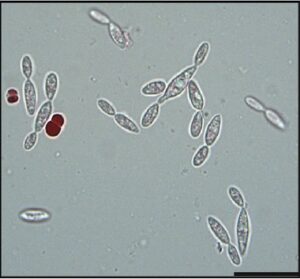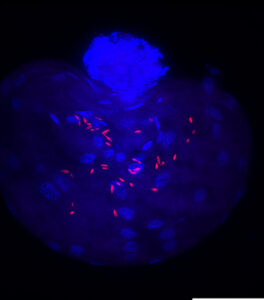Research page Shantanu Shukla MRDG IISc
Our latest research
We characterize the microbiome of the Indian lac insect Kerria lacca, identifying two major endosymbionts of the insect.
Using 16S rRNA and 18S rRNA amplicon sequencing, we identify a Wolbachia and a novel yeast-like symbiont (YLS) related to the Ophiocordyceps fungus in the insect. Using a combination of approaches involving whole genome sequencing, metatranscriptomics and fluorescence microscopy, the study shows that the tyrosine side chain and the polyketide backbone of the lac pigment are encoded only in the genome of the YLS, not in the genomes of the host insect or the Wolbachia bacterium. Genomic and transcriptomic analysis show that the YLS genome also codes for essential amino acids and vitamins missing from the insects diet, thus allowing it to adapt to diet consisting exclusively of plant sap.

 . The yeast-like symbiont in the insect hemolymph and oocyte.
. The yeast-like symbiont in the insect hemolymph and oocyte.
We use long read Oxford Nanopore Technology for whole-genome sequencing of the host and the endosymbionts.
Genomes of the following organisms have now been submitted at NCBI
1. The lac insect Kerria lacca (GCA_051170995.1)
2. The Yeast-like symbiont “KLYLS” (GCA_051170975.1)
3. The Wolbachia endosymbiont of K. lacca
The full publication and all details can be accessed here.
Research
We use a multidisciplinary approach to elucidate the molecular and cellular nuts-and-bolts of insect-microbiome long term associations in order to gain a better understanding of how and why the interacting organisms show the traits that we observe. The lab asks questions at multiple levels ranging from molecules to organisms and communities.
The research primarily uses methods in
1. Bioinformatics (whole genome sequence analysis, metagenomics, amplicon sequencing, metatranscriptomics) for studying insect microbiome interactions
2. Microscopy: Epifluorescence and confocal microscopy to visualize microbial transmission and tissue-specific localization of microbes.
3. Molecular biology to characterize gene density and expression using PCR, qPCR and RT-PCR as well as droplet digital PCR.
4. Microbial ecology to characterize microbial communities using culture dependent and culture independent methods.
5. Insect physiology and ecology to study the role of microbial symbionts in digestion, detoxification, nutritional supplementation and production of primary and secondary metabolites.
We aim to use our understanding of fundamental aspects of insect-microbiome associations to develop applications in health and agriculture.

Illustration showing potential applications of studying insect-microbe associations. For more details see the original paper in Applied Microbial Biotechnology.